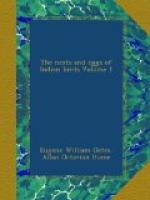They lay four or five eggs. I have quite as often found the latter as the former number. I have never myself seen six eggs in one nest, but I have heard, on good authority, of six eggs being found.
Captain Unwin writes: “I found a nest of the Bow-billed Corby in the Agrore Valley, containing four eggs, on the 30th April. It was placed in a Cheer tree about 40 feet from the ground, and was made of sticks and lined with dry grass and hair.”
Mr. W. Theobald makes the following remarks on the breeding of this bird in the Valley of Cashmere:—
“Lays in the third week of April. Eggs four in number, ovato-pyriform, measuring from 1.6 to 1.7 in length and from 1.2 to 1.25 in breadth. Colour green spotted with brown; valley generally. Nest placed in Chinar and difficult trees.”
Captain Hutton tells us that the Corby “occurs at Mussoorie throughout the year, and is very destructive to young fowls and pigeons; it breeds in May and June, and selects a tall tree, near a house or village, on which to build its nest, which is composed externally of dried sticks and twigs, and lined with grass and hair, which latter material it will pick from the backs of horses and cows, or from skins of animals laid out to dry. I have had skins of the Surrow (Noemorhaedus thar) nearly destroyed by their depredations. The eggs are three or four in number.”
From the plains I have very few notes. I transcribe a few of my own.
“On the 11th March, near Oreyah, I found a nest of a Corby—good large stick nest, built with tamarind twigs, and placed fully 40 feet from the ground in the fork of a mango-tree standing by itself. The nest measured quite 18 inches in diameter and five in thickness. It was a nearly flat platform with a central depression 8 inches in diameter, and not more than 2 deep, but there was a solid pad of horsehair more than an inch thick below this. I took the mass out; it must have weighed half a pound. Four eggs much incubated.
“Etawah, 14th March.—Another nest at the top of one of the huge tamarind-trees behind the Asthul: could not get up to it. A boy brought the nest down; it was not above a foot across, and perhaps 3 inches deep; cavity about 6 inches in diameter, thickly lined with grass-roots, inside which again was a coating of horsehair perhaps a rupee in thickness; nest swarming with vermin. Eggs five, quite fresh; four eggs normal; one quite round, a pure pale slightly greenish blue, with only a few very minute spots and specks of brown having a tendency to form a feeble zone round the large end. Measures only 1.25 by 1.2. Neither in shape, size, nor colour is it like a Corby’s egg; but it is not a Koel’s, or that of any of our parasitic Cuckoos, and I have seen at home similar pale eggs of the Rook, Hooded Crow, Carrion-Crow, and Raven.
“Bareilly, May 10th.—Three fresh eggs in large nest on a mango-tree. Nest as usual, but lined with an immense quantity of horsehair. We brought this home and weighed it; it weighed six ounces, and horsehair is very light.”




